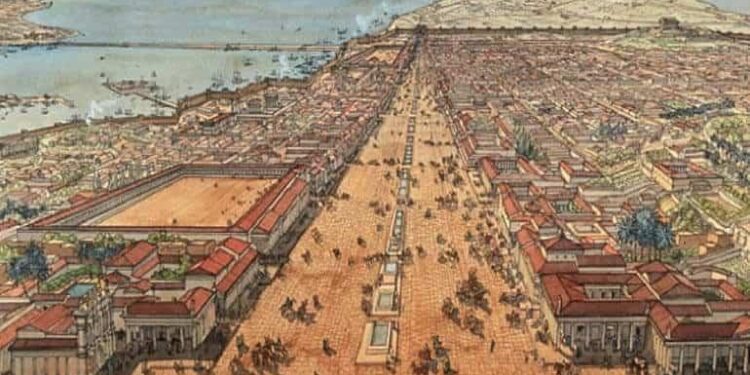Alexandria’s Endangered Heritage: Cleopatra’s Birthplace Sinking Into the Mediterranean
Once a flourishing center of culture, commerce, and intellect in ancient Egypt—and famously recognized as the birthplace of Cleopatra—the historic city of Alexandria now confronts an escalating environmental crisis. Accelerated coastal erosion combined with rising sea levels are steadily swallowing this iconic Mediterranean metropolis, imperiling its invaluable archaeological sites and centuries-old relics. As climate change intensifies, scientists and heritage experts are racing against time to document and safeguard what remains before these treasures disappear beneath the waves. This article explores the mounting ecological threats facing Alexandria and highlights urgent preservation efforts aimed at protecting its irreplaceable legacy.
Alexandria’s Coastal Landscape Under Siege from Climate Change
Once renowned as a beacon of knowledge—home to wonders like the legendary Lighthouse of Alexandria—this ancient city now grapples with relentless encroachment by the Mediterranean Sea. Global warming has driven sea levels to record highs due to melting polar ice caps and thermal expansion, hastening shoreline retreat along Alexandria’s coast. The consequences for archaeological landmarks are dire: many structures face flooding or collapse as natural defenses erode.
Several key factors contribute to this rapid degradation:
- Global Temperature Rise: Increased heat accelerates glacial meltwater influx into oceans.
- Urban Expansion: Coastal infrastructure disrupts sediment flow, exacerbating natural erosion.
- More Frequent Storm Surges: Intensified weather events cause higher tides that undermine fragile ruins.
In response, local authorities have begun evaluating various protective measures designed to slow or halt further damage:
| Protection Method | Description |
|---|---|
| Seawall Construction | Erecting physical barriers along vulnerable shorelines to absorb wave energy. |
| Sandy Beach Replenishment | Dredging and depositing sand onto eroded beaches for natural buffer restoration. |
| Ecosystem Rehabilitation Projects | Reviving coastal wetlands and mangroves that act as natural shields against erosion. |
Safeguarding Cleopatra’s Birthplace Amid Escalating Environmental Risks
The accelerating impacts of climate change pose existential threats not only to Alexandria’s physical landscape but also its cultural identity tied closely with figures like Cleopatra VII. Rising seas coupled with stronger storms have already claimed significant portions of this historic cityscape, threatening priceless artifacts that narrate Egypt’s illustrious past.
Preservation initiatives focus on balancing environmental mitigation with sustainable tourism development:
- Shoreline Defense Systems: Building durable barriers tailored specifically for vulnerable zones prone to flooding.
- Scientific Research Programs: Funding long-term studies on climate effects targeting heritage conservation strategies.
- Civic Participation Efforts: Empowering local communities through education campaigns fostering stewardship over their ancestral sites.
This multifaceted approach aims not only at protecting remnants from immediate harm but also ensuring resilience against future climatic uncertainties through innovation and global cooperation.
Critical Steps Required Now To Preserve Alexandria’s Archaeological Treasures From Coastal Decline
Home once again not just to one but multiple world-renowned historical marvels—including the Great Library site—the city faces an alarming rate of land loss due primarily to intensified weather patterns linked directly with climate instability.Recent extreme weather events worldwide underscore how vulnerable such coastal cities remain amid shifting climates.
Experts estimate that without swift intervention within decades many critical Greco-Roman era ruins will be submerged permanently beneath rising waters:
- The construction of advanced seawalls: Robust engineering solutions combining concrete structures with nature-based defenses can reduce flood risks significantly.
- Diligent Archaeological Surveillance: Continuous monitoring allows early detection of structural weaknesses enabling timely reinforcement or excavation.
Below is an overview highlighting some key endangered sites alongside their current condition assessments:
| Site Name | Current Condition | Projected Year Of Significant Loss |
|---|---|---|
| Great Library Of Alexandria Site | Critical Condition – At High Risk Of Submersion And Structural Collapse | 2030 Approximate Loss Year Expected |
| Ancient Lighthouse Remains (Pharos) | Severe Damage Due To Erosion And Flooding Threats Presently Observed | < TD >2025 Estimated Critical Threshold Year|
Conclusion: Preserving A Timeless Cultural Treasure For Future Generations
As one witnesses Alexandria—a once vibrant epicenter for scholarship, trade, and royal history—succumb gradually under nature’s unyielding forces, it becomes clear how delicate our shared human heritage truly is. The ongoing rise in sea levels coupled with accelerated coastline erosion starkly illustrate humanity’s complex relationship with our environment.
To prevent irreversible loss requires coordinated action among archaeologists, policymakers, conservationists—and crucially—the local population who hold custodianship over these legacies today. Only through innovative engineering solutions paired with international collaboration can we hope to protect both tangible monuments like Cleopatra’s birthplace alongside intangible cultural narratives embedded within them.
Alexandria continues captivating imaginations worldwide—not merely as a symbol from antiquity but as a living testament demanding urgent care so future generations may experience its grandeur firsthand rather than through fading memories lost beneath encroaching seas.














